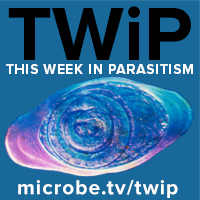 Hosts: Vincent Racaniello, Dickson Despommier, and Daniel Griffin
Hosts: Vincent Racaniello, Dickson Despommier, and Daniel Griffin
The prolific podcast-shedding Hosts solve the case of the Global Health Intern with a snakelike lesion on her foot, and reveal the role of a single-stranded DNA binding protein in differentiation of trypanosomes.
Click arrow to play
Download TWiP #124 (61 MB .mp3, 100 minutes)
Subscribe (free): iTunes, RSS, email
Become a patron of TWiP.
Links for this episode:
- RPA protein and differentiation of T. cruzi (PLoS NTD)
- Image credit
- Letters read on TWiP 124
Case Study for TWiP 124
28 yo male from referral hospital near thai-burma border. Fever and chills 2 days, feels poorly, small amount of dark urine. Severe shaking chills, 1x per day, no rash. No diarrhea, difficulty breathing. Seen by local health care volunteer, went to hospital then tertiary hospital in Bangkok. Exposure history to pigs, dogs, insects, etc. Involved in timber industry and farming, sleeping out at night with no cover, clothes and sandals. No meds. Not married, family lives with him. Family is fine. Sleep in dwelling but no screens. No toxic habits, HIV negative, sexually active but not brothels. High fever, low bp, rapid heart rate, breathing rapidly, scleral icterus, dry mucus membranes, neck supple, lungs clear. 2/6 systolic murmur. Abdomen soft but tender, enlarged liver and spleen. Many cuts, bruises, bug bites. Labs: low platelets, low hematocrit, low glucose. Blood smear: abnormal, 5-10% infected RBCs with multiple band forms.
Send your case diagnosis, questions and comments to [email protected]


Hi Hosts. Dave Carlson here from now sunny and warm southern Alberta Canada where it is -2c and windy with a chinook blowing, after almost a month in the -25-30c range. My wife Connie( a retired animals health tech with a love for parasitology) was doing a happy dance when we listened to #124 and as the discription started she said hook worm and got it correct.
I’m a sheep, alpaca and llama shearer so I see parasitism from the other side. In south, central British Columbia there is a tick( I believe it is a deer tick that paralizes camalids( alpacas and llamas) I’ve seen cases where as few as 2 ticks will knock a 400 lbs llamas down and until the ticks are removed the llamas can’t get up. We get called in for emergency shears to help find the ticks. In one case we received a panic call that a breeders top stud was down. We were only about 20 minutes away so went over. It was dark when we got there so by the headlights of the van and a couple of flash lights I shore the stud. I should say when we arrived he was on his side drooling and unable to move. We found 2 engorged ticks high on his hip( and removed and bagged them) and 2 newly attached ticksthat were also removed and bagged in that area. It took me about 10 minutes to shear him and by the time we were packing up he was sternal and starting to chew his cud. When we went back to shear the rest of the herd the next morning he was up grazing. I should mention that a vetrenarian had checked him out the afternoon before and figured there was nothing that could be done for him. Just before noon the vet called to see when he had died and couldn’t believe it when the owner said the stud was up and doing fine. Long story but I was wondering after listening the first few episodes if the toxin that the ticks use is similar to the toxin that the worms used to stop the gut.
Dave here after hitting post I realized I should have said venom rather than toxin
Hi there esteemed Doctors. Love the show. You are getting me way to interested in that which lives within and sqirms In show 12 you mentioned that they were looking for a way of finding out how any mice were infected with Toxoplamosis. Here is a simple experiment. Four groups of mouse traps. The first is the control. Untreated, should only catch the Darwins award mice. The second bated with the standard peanut butter. The third bated with peanut butter and sprayed with cat urine, and the fourth is unbated but sprayed with cat urine. All traps put out in the same area. My hypothesis would be that the second group would catch mostly uninfected mice. The third group would catch infected mice because the uninfected ones would avoid the cat urine. Then Colombo turn for the door and you say, but what about the fourth group. He turns back” Oh yeh right. The fourth group. We would expert there to be the same number in the fourth group as the first group if the mices ability to smell cat urine was reduced. However, however if the mice are atracked to the cat urine then you should see as many mice in group four traps and in group three traps.
Dave the sheep shearer from Sunny southern Alberta Canada where it is -10c and dark(630am)